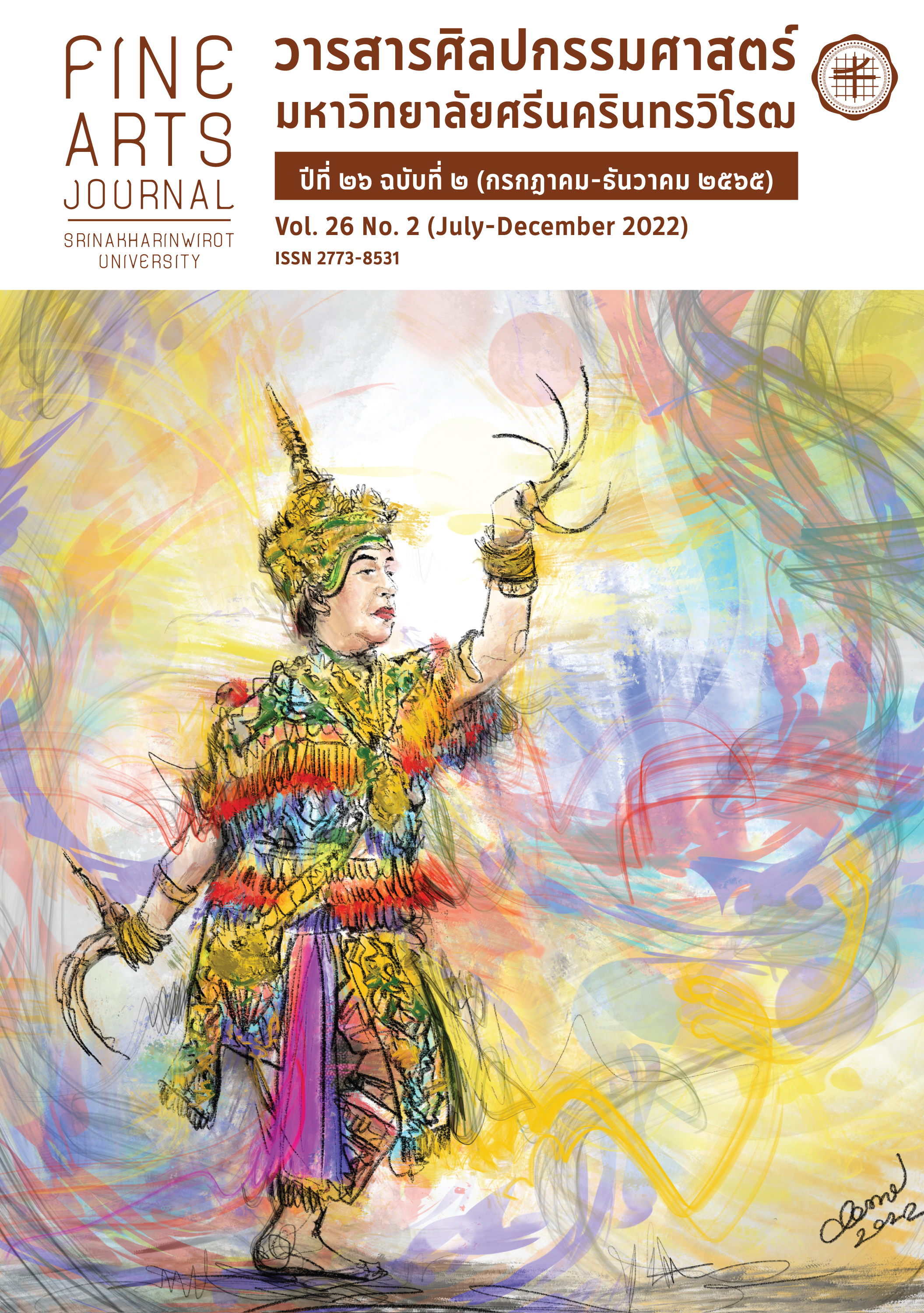THE KNOWLEDGE TRANSFER OF THAI CARTOONISTS
Keywords:
Knowledge transfer, Cartoon drawing, Thai cartoonistAbstract
This research article is a study of the process of the knowledge transfer of Thai cartoonists. The objectives of this research are (1) to examine the concept and process of the knowledge transfer of Thai cartoonists and (2) to analyze the correlation between cartoon drawing and art education. The qualitative data analysis was applied to compile, describe, analyze, and present the results in the form of essays. The results of the study showed that as a result of graduating from the art programs, most Thai cartoonists will have the opportunity to transfer their knowledge after they have publicized their works for a period of time. The aims of the teaching concept were (1) the students should be able to create their works according to plans, (2) the teaching contents must be modified to serve learners’ ability, (3) the introduction of the lesson will be created to attract the learners’ attention, (4) the teaching methods will focus on the lectures along with demonstrations and practical exercises, (5) the criticism will focus on seeking to understand the students’ work and identifying the weaknesses of the work to provide corrective feedback to the students, and (6) creating a relaxing learning environment. In addition, two problems related to the transference of knowledge were found: (1) the attraction and preparation for learning and (2) equipment, place, and support, and the transference of knowledge primarily based on technology and social media. With regard to the correlation between cartoon drawing and art education, it was found that cartoon drawing was correlated with art education, in terms of both the concept and the method. Therefore, teaching cartoon drawing can be applied to the management of art education.
Downloads
References
เก่ง พัดสิด. (2544). แนะนำการทำงาน สมัครงาน และการเขียนการ์ตูน. กรุงเทพมหานคร: Editor 1999.
ณัฐฌา โต๊ะเงิน. (2548). กระบวนการสร้างสรรค์การ์ตูนของนักเขียนการ์ตูนไทย: 2470-ปัจจุบัน
(วิทยานิพนธ์ปริญญามหาบัณฑิต). มหาวิทยาลัยศิลปากร, กรุงเทพมหานคร. สืบค้นเมื่อ 7 มกราคม
, จาก http://www.thapra.lib.su.ac.th/objects/thesis/fulltext/thapra/Nutcha_Tokngean/Fulltext.pdf
ไตรภัค ศุภวัฒนา. (2555). หมูหมี สอนวาดการ์ตูน. กรุงเทพมหานคร: สตาร์พิคส์.
ถิรนันท์ อนวัชศิริวงศ์, และพิรุณ อนวัชศิริวงศ์. (2553). การ์ตูน: มหัศจรรย์แห่งการพัฒนาสมองและ
การอ่าน. กรุงเทพมหานคร: สถาบันการ์ตูนไทย มูลนิธิเด็ก.
ธนิสร์ วีระศักดิ์วงศ์, และศรัณย์ ทองปาน. (2559). โฉมหน้าการ์ตูนไทยในรอบ 20 ปี. สารคดี, 32(376), 96-103.
ธิดารัตน์ แซ่ตั้ง. (2548). การพัฒนาบทเรียนคอมพิวเตอร์มัลติมีเดียเรื่องการวาดการ์ตูนเรื่องเบื้องต้น
สำหรับนักเรียนช่วงชั้นที่ 3 (สารนิพนธ์ปริญญามหาบัณฑิต). มหาวิทยาลัยศรีนครินทรวิโรฒ,
กรุงเทพมหานคร. สืบค้นเมื่อ 7 มกราคม 2564, จาก http://thesis.swu.ac.th/swuthesis/Ed_
Tech/Tidarat_S.pdf
นิพนธ์ แจ่มดวง, ประเสริฐ ผลิตผลการพิมพ์, พิมพ์พิมล ธงเธียร, ศักดา วิมลจันทร์, และกู้เกียรติ ญาติเสมอ.
(2548). การ์ตูน: โลกใบใหญ่ของความรักและจินตนาการ. กรุงเทพมหานคร: เรือนแก้วการพิมพ์.
นวลลออ ทินานนท์. (2542). เอกสารประกอบการสอน ศล 211 หลักสูตรและการสอนศิลปศึกษา 1.
กรุงเทพมหานคร: คณะศิลปกรรมศาสตร์ มหาวิทยาลัยศรีนครินทรวิโรฒ ประสานมิตร.
นาตยา เที่ยงมิตร. (2559). วิธีการวาดและเล่าเรื่องในการ์ตูนช่องขององอาจ ชัยชาญชีพ วิศุทธิ์
พรนิมิตรและทรงศีล ทิวสมบุญ (วิทยานิพนธ์ปริญญามหาบัณฑิต). มหาวิทยาลัยศิลปากร,
กรุงเทพมหานคร. สืบค้นเมื่อ 7 มกราคม 2564, จาก http://ithesisir.su.ac.th/dspace/handle/123456789/1247
นิรวาณ คุระทอง. (2553). ประวัติย่อการ์ตูนไทย. กรุงเทพมหานคร: เล็ด คอมิค.
ปยุต เงากระจ่าง. (2536). โรงเรียนเขียนการ์ตูน (พิมพ์ครั้งที่ 2). กรุงเทพมหานคร: เค แอนด์ พี บุ๊คส์.
มาฆพร สาทิสสะรัต. (2543). มาเรียน...เขียนการ์ตูน กับรัตนะ สาทิส. กรุงเทพมหานคร: วิบูลย์กิจ.
ลี, สแตน และบุสเซมา, จอห์น. (2560). Drawing commics หัดวาดคอมิกส์สไตล์ "Marvel"
(ณิชา, ผู้แปล). นนทบุรี: ไอดีซีพรีเมียร์.
วีระ มณีรัตนะพร. (2554). การพัฒนาแบบฝึกทักษะวิธีวาดภาพการ์ตูนจากเส้นโครงร่างพื้นฐาน:
รายงานการวิจัย. กรุงเทพมหานคร: มหาวิทยาลัยเทคโนโลยีราชมงคลกรุงเทพ.
ศศิรินทร์ ยงศิริ. (2553). How to manga studio EX3 ทำการ์ตูนคอมิคได้ใน 7 วัน. กรุงเทพมหานคร:
มูลนิธิเด็ก.
สุชาติ ทองสิมา. (2546). จะสอนศิลปะเด็กอย่างไรดี?. วารสารศิลปกรรมศาสตร์ มหาวิทยาลัยศรีนครินทรวิโรฒ,
(2), 49-52. สืบค้นเมื่อ 7 มกราคม 2564, จาก http://thesis.swu.ac.th/swuarticle/Fi_Art/
Fi_Artsv11n2(22)p49.pdf
สำนักวิชาการและมาตรฐานการศึกษา. (2552). ตัวชี้วัดและสาระการเรียนรู้แกนกลางกลุ่มสาระการเรียนรู้
ศิลปะตามหลักสูตรแกนกลางการศึกษาขั้นพื้นฐาน พุทธศักราช 2551. กรุงเทพมหานคร:
สำนักวิชาการและมาตรฐานการศึกษา กระทรวงศึกษาธิการ.
สมาคมการ์ตูนไทย. (2552). ประวัติและความเป็นมา. สืบค้นเมื่อ 2 มกราคม 2564, จาก
http://thaicartoonassociation.blogspot.com/
อรอนงค์ ฤทธิ์ฤาชัย. (2548). ผิดหรือไม่ที่เด็ก ๆ จะวาดแต่ภาพการ์ตูน. สืบค้นเมื่อ 2 มกราคม 2564,
จาก http://202.28.92.106/research/files/108729-7-2-copying.doc
โอซามุ, เทะซึกะ. (ม.ป.ป.) คัมภีร์การ์ตูน (พรเพ็ญ, ผู้แปล). กรุงเทพมหานคร: วิบูลย์กิจ.
Downloads
Published
How to Cite
Issue
Section
License

This work is licensed under a Creative Commons Attribution-NonCommercial-NoDerivatives 4.0 International License.






